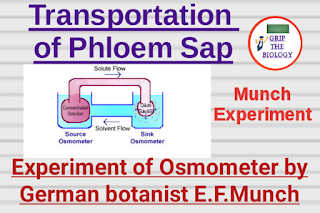Long distance transportation of food by phloem, Mass flow hypothesis
- The transportation of organic matter from the leaf where it is synthesised to other parts of plants through phloem is facilitated in long distance transportation of solute.
- T.G.Mason and E.J. Maskwell conducted an experiment to demonstrate the transport of sugars by the phloem.
- They removed a ring of phloem from the cotton plant and observed the position of phloem in both the above and below the portion of ring that was cut by them. They observed the accumulation of sugars above the ring.
- Phloem is the major path of translocation of material in plants. The material that is translocated by the phloem, is the most concentrated material in plants.
- This phloem material is termed as phloem sap. This material has highly negative osmotic potential. Analysis of phloem material reveals that phloem sap has sucrose as its main component.
- In some plants, in addition of sucrose, some oligosaccharides like raffinose, and some alcohol like mannitol, sorbitol also present in phloem sap. Glucose and galactose are also found in phloem sap. These are obtained by the hydrolysis of sucrose.
- Glucose and galactose are distributed in non conducting tissue and are directly involved in metabolism.There are several amino acids like glutamic acids, aspartic acid, alanine, threonine, etc are also reported in phloem sap.
- There are several protein and enzymes are also present in sap and play a role in carbohydrates and nitrogen metabolism.
- Phloem sap also has potassium ions, magnesium ions, chlorine ions etc.
- Some plant growth regulators like indole acetic acid and Abscisic acids are also found in phloem sap.
- Traces of iron, copper, molybdenum and some organic acid like malik acids are also part of phloem sap.
Munch Experiment to demonstrate mass flow hypothesis.
- There are various theories to understand the translocation of solute or sugars by phloem in plants.
- Out of these, the Mass flow or pressure flow hypothesis by Munch is widely accepted.
- According to this hypothesis, a force is involved in movement of organic material toward the downloads in phloem as a result of difference in osmotic pressure.
- The mass flow hypothesis or pressure flow hypothesis was given by German botanist E.F.Munch and this hypothesis was later elaborated by the Craft in 1938.
- The principle of mass flow hypothesis can be easily understood by simple experiments.
- Two osmometer A and B are connected by a tube. Osmometer A is filled with high concentration of sugar solution whereas osmometer B contains low concentrated sugar solution.
- Now both the osmometer are submerged in water. Wall of the osmometer acts as a semipermeable membrane and water is moved in both osmometers initially and causes a turgor pressure on both osmometers.
- Osmometer A develops high turgor pressure because it contains high concentration of solute. This increased turgor pressure in osmometer A causes mass flow of sugar solution towards the osmometer B.
- This movement of sugar solution continues till the solution in both osmometers attain the same concentration.
- If sugar or solute is continuously removed from osmometer B then movement of solution will also be continued from osmometer A to osmometer B.
- In a plant, osmometer A represents the source of organic matter or leaf where organic matter is synthesised by the photosynthesis and osmometer B represents the plant organs like root or stem where organic matter is transported.
- The connection tube between the osmometer represents the sieve tube or xylem tracheids.Due to absorption of water, source developed turgor pressure for movement of material.
The Pressure Flow or Mass Flow Hypothesis
- This hypothesis is used to explain the translocation of sugars from leaf to root or stem is called the pressure flow hypothesis.
- As glucose is prepared at the leaf by photosynthesis then it is converted into sucrose.
- The sugar is then moved in the form of sucrose into the companion cells and then into phloem sieve tube cells by active transport.
- This process of storing organic matter at the leaf produces a hypertonic condition in the phloem. Water in the adjacent xylem moves to the phloem by osmosis.
- As osmotic pressure builds up the phloem sap will move to areas of lower pressure.
- The sucrose moves out of the phloem sap by active transport into the cells which will use the sugar .
- As sugars are removed, the osmotic pressure decreases and water moves out of the phloem, returning eventually to xylem.

Comments
Post a Comment